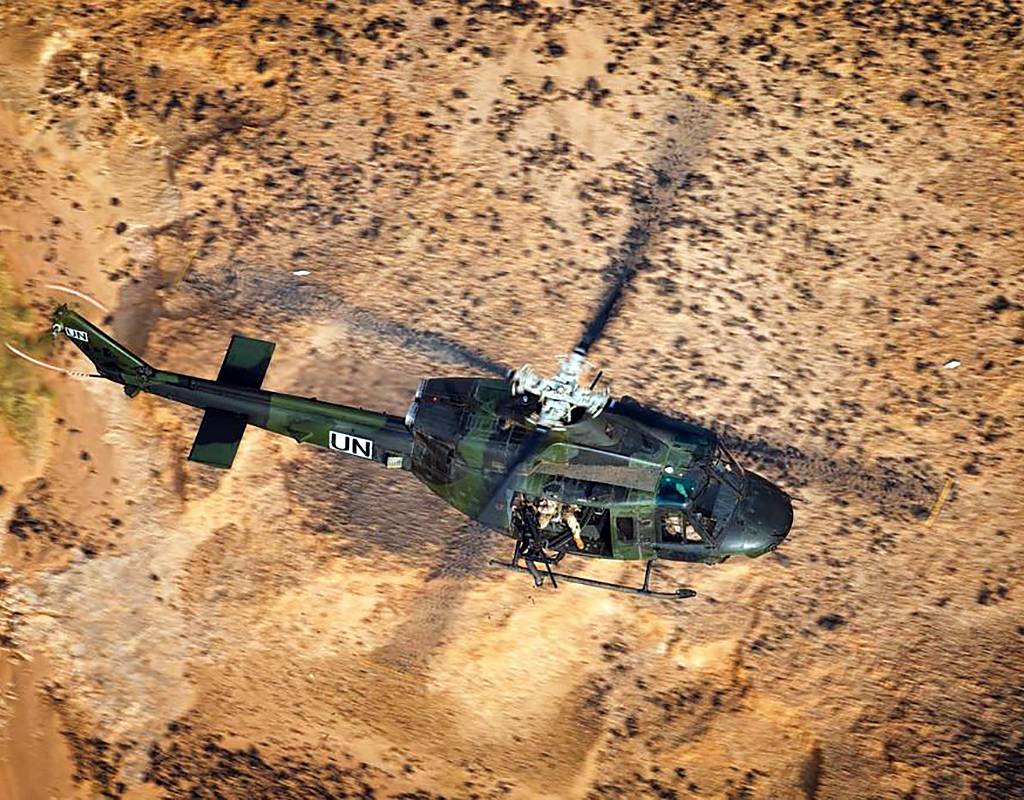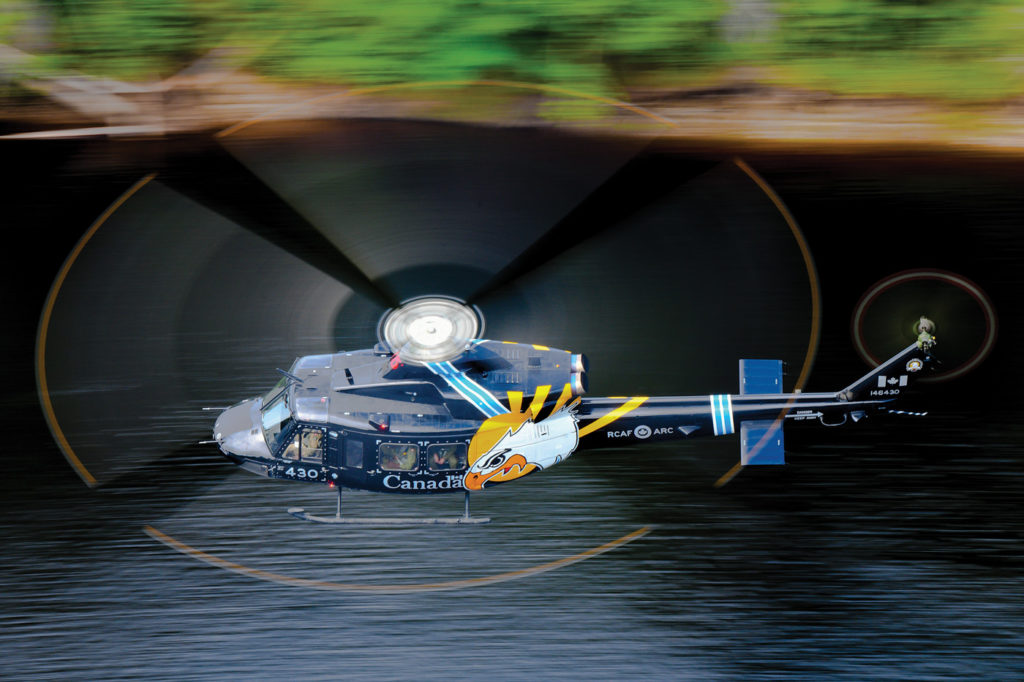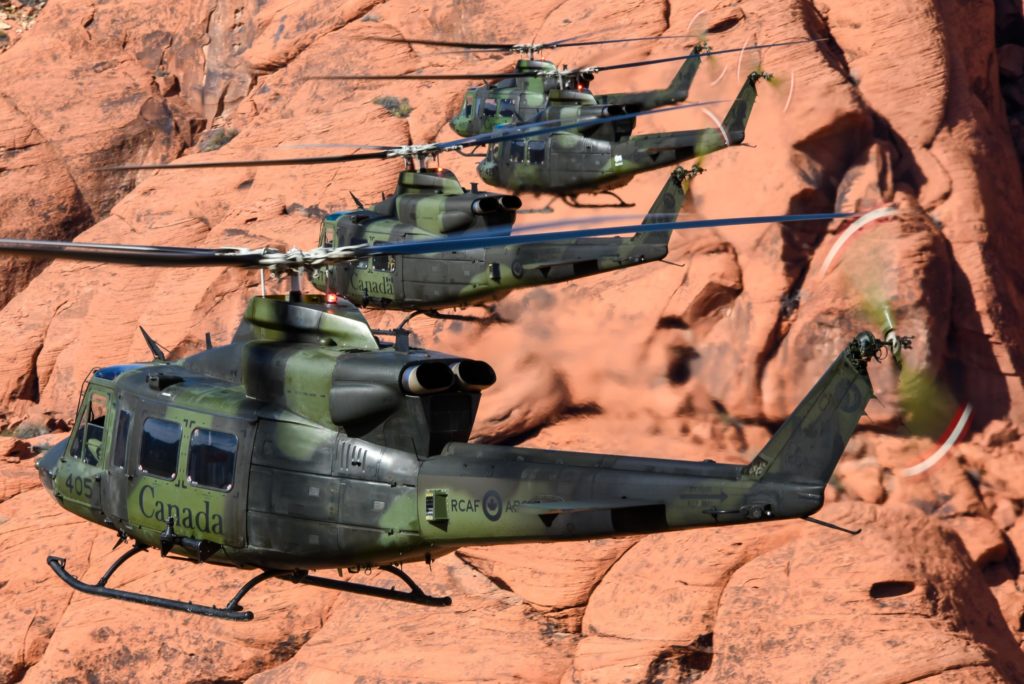
It might have started as a relatively straightforward helicopter life extension project, but the plan to see the CH-146 Griffon continue flying into the 2030s has become far more complex than many first imagined. And what comes next to replace the venerable multi-role airframe may be even more so.
On Feb. 15, 2021, Griffon number 467, the first of three CH-146 aircraft, landed at Bell Helicopter Textron Canada’s facility in Mirabel, Quebec, to begin a prototyping process that will include the design, development and installation of new cockpit displays and engines, integrate sensor systems, communications and cryptographic equipment, cockpit voice and flight recorders, navigation systems, automatic flight control systems, and control display units.
Known as the Griffon Limited Life Extension (GLLE), the program will eventually return to the Royal Canadian Air Force (RCAF) the CH-146 Charlie Griffon Mark II, what Lt. Col. Andrew Hewitt calls a “unique” airframe.
The flight path, however, could require a deft touch to navigate. Hewitt, who heads a small team under the director of air requirements (DAR) for tactical aviation, must satisfy the requirements of a diverse set of missions. The CH-146, a militarized variant of the Bell 412, provides not only tactical transport for the army, in particular its light infantry battalions — it is also a critical platform for special operations forces, flown by 427 Special Operations Aviation Squadron in Petawawa, Ontario; a domestic search-and-rescue (SAR) asset operated by 424 Transport and Rescue Squadron at 8 Wing Trenton, Ontario; and a frequently deployed utility platform for domestic response operated by combat support squadrons at 3 Wing Bagotville, Quebec, 4 Wing Cold Lake, Alberta, and 5 Wing Goose Bay, Newfoundland. Since the airframe first entered service in 1995, the RCAF has integrated 45 mission kits to meet different user needs.
“As we got into the definition phase and we were looking at the complexity of what we are trying to do, I think the mindset shifted,” said Hewitt, a CH-146 pilot and instructor with 408 Tactical Helicopter Squadron in Edmonton, Alberta. Hewitt also operated a CU-161 Sperwer unmanned aircraft in 2006 and 2007 in Afghanistan and flew a Royal Air Force Chinook during a three-year officer exchange between 2008 and 2011.
“Even though it is a straightforward project in terms of its goals — sustaining the current capability until the mid 2030s — what we are trying to achieve is a generational upgrade to the aircraft,” Hewitt added. “Consequently, the developmental process, as we have come to learn, is going to be unique and there will be a lot to do.”
Rather than earmark each of the prototypes for different systems such as avionics, mission kits or engines, Bell and the RCAF have adopted an “iterative approach” that will allow each prototype to build on the lessons from the previous one. If the idiomatic expression “third time’s a charm” holds true, the result will be an airframe ready for flight testing by late summer or early fall 2022.
The first aircraft will provide a platform for the basic avionics design and fitting for bespoke flight management and mission management systems, as well as a check on mission kit compatibility and, where necessary, interoperability. The second will incorporate the lessons learned and provide the basis for installation instructions of all systems for subcontractors. With the third prototype, Bell and the RCAF will have a final opportunity “to make sure we’ve got everything right,” Hewitt said.
While the RCAF has employed a block approach to upgrade avionics and mission systems on the CP-140 Aurora and complete a structural life extension, the process was conducted over two decades and the maritime patrol aircraft returned to service after each block. This is notably different.
“From what I have seen, [the prototype approach] is unique,” said Hewitt. “I don’t know of any other project like it right now, which is why it has been a significant learning curve.”
The government, which awarded Bell a contract in January 2019 valued at $90 million, is still finalizing the GLLE agreement with the manufacturer, so the timelines are not fixed. But the objective between “now and end of next summer . . . is to go through those three iterations of development so that we can have the aircraft ready for modification in 2023,” he said. Initial operating capability would begin by the end of 2024.
Until a new deal is reached, the design work is being completed under an in-service support contract that has been in place since 2011. The Griffon was first acquired from Bell in 1992 and 85 of the original 100 remain in service. All 85 will undergo the full modification.
Restoration job
“I tell people it is like pimp my car,” joked Donald Falardeau, referring to the MTV series Pimp My Ride, in which the host, rapper Xzibit, oversaw the restoration and hot-rodding of old cars. “You take everything out of it, including all the wire harnesses and boxes, and you start from scratch. Some of the boxes will be re-used but there are a lot of new boxes coming in.”

A former aerospace engineering officer on the CF-188 fighter program, Falardeau is Bell’s program manager for GLLE, overseeing all aspects of the upgrade. As much as possible, “we are trying to use off-the-shelf products that come from the 412 line,” including the latest evolution, the Bell 412EPX, he told a virtual forum hosted by the Vertical Flight Society on May 11.
The overhaul of each CH-146 includes rewiring and installing some 40 wiring harnesses and power cables, a new console and “a mix of avionics from the commercial 412,” a mission management system integrated with the Wescam MX-15 EO/IR imaging system, which was introduced on the Griffon about seven years ago, and new radios and cryptographic equipment in the nose of the aircraft. Several of the Griffon’s many antennas will be removed, replaced, or repositioned.
While some systems will be new, many of the mission kit enhancements are software-related, explained Hewitt. “It’s on the mission kits and the functionality of the flight management and mission management software that we have had most of the changes and we have had to adapt during the definition phase.”
In addition to addressing ongoing obsolescence issues with certain components, the avionics improvements will also meet civil air traffic management regulations that now require ADS-B Out for identification, position, altitude, and velocity. Aircrews will also receive tablets for flight planning and systems management.
Parts obsolescence may be less of a concern in the future, with Bell planning to introduce the option for some 3D printed parts with the modifications, said Falardeau.
For pilots who have expressed frustration with the rotorcraft’s power, the most significant change might be the introduction of an electronically controlled Pratt & Whitney Canada PT6T-9 Twin-Pac engine.
“Once you got to the limits of the performance envelope, you had a little bit of twitchiness in the gauge, and it would just take a little muscle impulse at the wrong time to enter an over-torque condition,” said Hewitt of CH-146 performance. “With digital engine control, we are much more confident pilots will have a greater degree of fidelity in handling the aircraft at those performance limits. You don’t have to have as much of a personal safety buffer to operate at the envelope, which does give you that extra few percent of performance, which makes a big deal in high, hot environments.”
Falardeau attributed the manner and speed at which GLLE has progressed to a tight working relationship with the Air Force and government departments. Frequent and productive program review meetings as well as design working groups with significant input from the user communities have steered the project to this point, while a robust risk management system and “good processes for change requests” have helped eliminate surprises and manage what he called “legitimate scope creep” as raw estimates have become firm costs and requirements have been solidified.
In line with that approach, Bell, the Aerospace Engineering Test Establishment and the RCAF Operational Test and Evaluation unit intend to form one test team, he added. “There will be one document that will guide everything for the execution of tests, for qualification and certification.”
Refining the requirements has involved a constant back and forth between the Air Force and the Army and SOF to ensure the modifications meet specific missions, said Hewitt. The project team has pulled lessons from recent operations such as the forward aeromedical evacuation support role in Mali in 2018-19.
It’s also monitoring the progress of a CH-149 Cormorant midlife upgrade program that will modernize the RCAF’s primary SAR helicopter in a configuration similar to the Norwegian all-weather search-and-rescue helicopter and return the Cormorant to 424 Squadron at 8 Wing Trenton. Until then, the Griffon will remain the SAR rotorcraft for Great Lakes response.

“The Bell 412 has been a stellar platform, but it is power-limited to do such a diverse set of roles,” Hewitt observed. “As a multi-purpose utility helicopter, it can never do one thing perfectly, but it can do a lot of things really well.”
More precise army and SOF requirements will have to wait for the eventual Griffon replacement, he added.
Tactical aviation system?
Planning for what comes next is now underway. In the summer of 2020, Hewitt officially stood up a unit of one — himself — to begin the process with others in DAR of identifying the future capabilities needed by user communities. Still in the pre-definition phase, the project is being called the next Tactical Aviation Capability Set (nTACS), a nod to the fact that the eventual solution might not be a platform-for-platform replacement.
The DAR team has engaged with both the U.S. Army Future Vertical Lift (FVL) program and NATO’s Next-Generation Rotorcraft Capabilities project, a five-country collaboration announced in November 2020 to modernize multi-role rotorcraft fleets that are anticipated to retire between 2035 and 2040.
In recent presentations, U.S. Army senior officers have suggested the FVL “ecosystem” they are constructing will fundamentally change tactical aviation. The traditional limitations of speed, range, endurance and payload could all be “smashed over the next 15 years,” Hewitt noted. And increased options for remotely piloted systems — something the U.S. Army is trialing under Project Convergence with a scalable control interface that will allow soldiers to control an UH-60 Black Hawk helicopter — could significantly change the calculus of what is possible after GLLE, especially as operations increase in the Arctic.
“What we are coming to realize is we are not necessarily looking at a replacement aircraft for this capability, we are looking at a replacement set,” Hewitt said. “We want to leave the door open for different types of airframes.”
In a 2018 interview, Brig. Gen. Michel Lalumiere, then director general of air force development, described the Griffon replacement as a “tactical system” with the agility, integrated weapons and sensors, satellite connectivity and endurance to fulfill a range of roles.
That thinking still holds true, said Hewitt.
The project was originally called the tactical reconnaissance and utility helicopter concept, but conversations with the Canadian Army and SOF about their future needs suggest “a fair amount of diversity” in what they will be seeking, he noted.
![]()
The Griffons, which each accumulate about 300 flight hours every year, were selected to fill the roles of three helicopters — Boeing-Vertol CH-47C Chinook, CH-136 Kiowa and Bell CH-135 Twin Huey — so combining diverse missions in a single airframe would not be novel.
“But are we confident right now that we are going to be able to pick an airframe to come on service in 15 to 20 years like we did with the Griffon in 1995?” Hewitt said. “Maybe, but maybe not. That is why it is called a set.”
Hewitt cautioned against equating Canadian with American requirements as the FVL program advances demonstrators under its Future Attack Reconnaissance Aircraft (FARA) and Future Long-Range Assault Aircraft (FLRAA) projects. Both the Bell V-280 Valor and the Sikorsky-Boeing SB>1 Defiant offer advanced capabilities of interest to nTACS, but not necessarily the exact solution.
“When I look at them, I see developments that check what the U.S. Army is looking for. I don’t necessarily see things that check what we are looking for,” Hewitt said. “We have a smaller force with a more diverse set of things to do, so we have to think of more multi-capable platforms, whereas I think the U.S. Army has the luxury of looking for more bespoke and tailored capabilities. I also understand from the European point of view how they are looking at it. It’s too early to tell if it is between the two of them or if there is a third way. I think there is going to be quite a few options we will be able to leverage to provide the best capability we can.”
As much as speed, range, endurance, and payload remain central to any future platform, Hewitt is focused on data management and integration with a joint force in an all-domain digital battlespace. The Army operating concept of dispersed operations will “require a capability not unlike you would see with the F-35 Joint Strike Fighter or some of the other advanced platforms coming out today,” Hewitt said.
Data links, sensor and information management, and interoperability will be among the mandatory requirements.
It is still early days for the project. Preliminary discussions have been held with the Air Force, Army and SOF “to make sure we are in agreement with what we are proposing” and Hewitt will soon seek Defence Capability Board approval to begin identifying and developing the options for a capability to enter service in the mid 2030s.





